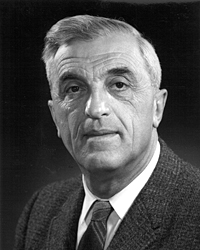Felix Bloch
| Felix Bloch | |
|---|---|
 |
|
| Born |
23 October 1905 Zürich, Switzerland |
| Died | 10 September 1983 (aged 77) Zürich, Switzerland |
| Citizenship | Swiss, American |
| Nationality | Swiss |
| Fields | Physics |
| Institutions |
University of California, Berkeley Stanford University |
| Alma mater | ETH Zürich and University of Leipzig |
| Doctoral advisor | Werner Heisenberg |
| Doctoral students | Carson D. Jeffries |
| Known for |
NMR Bloch wall Bloch's Theorem Bloch Function (Wave) Bloch sphere |
| Notable awards | Nobel Prize for Physics (1952) |
Felix Bloch (23 October 1905 – 10 September 1983) was a Swiss physicist, working mainly in the U.S. He and Edward Mills Purcell were awarded the 1952 Nobel Prize for "their development of new ways and methods for nuclear magnetic precision measurements." In 1954–1955, he served for one year as the first Director-General of CERN.
Bloch was born in Zürich, Switzerland to Jewish parents Gustav and Agnes Bloch.
He was educated at the Cantonal Gymnasium in Zurich and at the Eidgenössische Technische Hochschule (ETHZ), also in Zürich. Initially studying engineering he soon changed to physics. During this time he attended lectures and seminars given by Peter Debye and Hermann Weyl at ETH Zürich and Erwin Schrödinger at the neighboring University of Zürich. A fellow student in these seminars was John von Neumann. Graduating in 1927 he continued his physics studies at the University of Leipzig with Werner Heisenberg, gaining his doctorate in 1928. His doctoral thesis established the quantum theory of solids, using Bloch waves to describe the electrons.
In 1940 he married Lore Misch.
He remained in European academia, studying with Wolfgang Pauli in Zürich, Niels Bohr in Copenhagen and Enrico Fermi in Rome before he went back to Leipzig assuming a position as privatdozent (lecturer). In 1933, immediately after Hitler came to power, he left Germany because he was Jewish. He emigrated to work at Stanford University in 1934. In the fall of 1938, Bloch began working with the University of California at Berkeley 37" cyclotron to determine the magnetic moment of the neutron. Bloch went on to become the first professor for theoretical physics at Stanford. In 1939, he became a naturalized citizen of the United States. During WW II he worked on nuclear power at Los Alamos National Laboratory, before resigning to join the radar project at Harvard University.
...
Wikipedia
